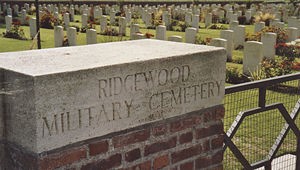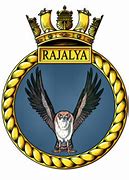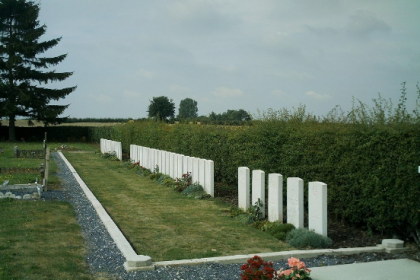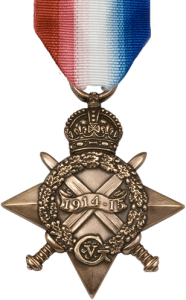
The 1914/15 Star was a campaign medal of the British Empire for service in World War one. This Star is identical with the 1914 Star in every respect except that the centre scroll bears the dates “1914 – 15” and the two small scrolls bearing “Aug” and “Nov” are omitted.
The 1914/15 Star was approved in 1918, for issue to officers and men of British Imperial Forces who saw service in any theatre of war against the Central Powers between 5th August, 1914, and 31st December, 1915, except those eligible of the 1914 Star.
Recipients of this medal also received the British War Medal and Victory Medal – it was never awarded singly. These three medals were sometimes irreverently referred to as Pip, Squeak and Wilfred with Pip representing either this medal or the 1914 Star, only one of which could be awarded to a soldier; Squeak represented the British War Medal; and Wilfred represented the Victory Medal.
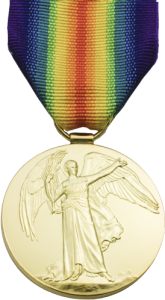
The Victory Medal (also called the Inter Allied Victory Medal) is a bronze medal that was awarded to all who received the 1914 Star or 1914-15 Star and, with certain exceptions, to those who received the British War Medal. It was never awarded alone. These three medals were sometimes irreverently referred to as Pip, Squeak and Wilfred
The medal of which the basic design and ribbon was adopted by Belgium, Brazil, Cuba, Czechoslovakia, France Greece, Italy, Portugal, Romania, Siam, Union of South Africa and the USA in accordance with the decision as taken at the lnter-Allied Peace Conference at Versailles but in a particular form of a historic Greek monument as determined by each nation, with the exception of the nations of the far east who issued the medal but with a different design.
Eligibility for this award consisted of having been mobilized in any of the fighting services and having served in any of the theatres of operations, or at sea, between midnight 4th/5th August, 1914, and midnight, 11th/12th November, 1918. Women who served in any of the various organizations in a theatre of operations were eligible, such as nurses, members of the Women’s Royal Naval Service, Woman Army Auxiliary Corps, Women’s Royal Air Force, canteen staff and members of the many charitable services
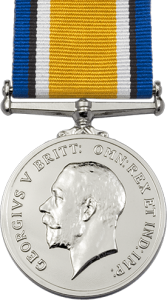
The British War Medal was a campaign medal of the British Empire, for service in World War One. It commemorates some of the most terrible battles the world has ever known. The casualties in the Ypres Salent and on the Somme for 1915 to 1918 were more than our total for the Second World War.
The medal was approved in 1919, for issue to officers and men of British and Imperial forces who had rendered service between 5th August 1914 and 11th November 1918. Officers and men of the Royal Navy, Royal Marines, and Dominion and Colonial naval forces (including reserves) were required to have completed 28 days mobilised service – the medal was automatically awarded in the event of death on active service before the completion of this period.
The medal was later extended to cover and award the services in the period 1919–20 for mine-clearing at sea as well as participation in operations in North and South Russia, the eastern Baltic, Siberia, the Black Sea, and the Caspian. This medal was issued singly without the Allied Victory Medal to certain regular and mobilized personnel who did not see any fighting.
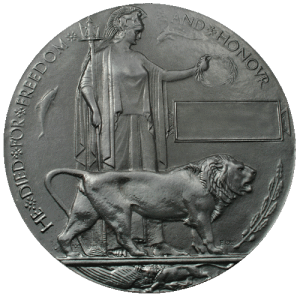
The World War One Memorial Plaque was made from Bronze and hence it was popularly known as the “Dead Man’s Penny” among front-line troops, also becoming widely known as, the “Death Penny”, “Death Plaque” or “Widow’s Penny”. It was in October 1916 that the British Government setup a committee for the idea of a commemorative plaque that could be given to the next of kin for those men and women whose deaths were due to the First World War of 1914-18.
The first a family would know of the death of family member was the arrival of a telegram from the War Office. This would be followed by the World War One Death Plaque and any medals the serviceman would have earned serving his country.
The original plaque was a 12 centimetre disk cast in bronze gunmetal, which included an image of Britannia and a lion, two dolphins that represented Great Britain’s sea power and the emblem of Imperial Germany’s eagle being torn to pieces by another lion. Britannia is holding an oak spray with leaves and acorns. Beneath this was a rectangular tablet where the deceased name was cast into the plaque. No rank was given as it was intended to show equality in their sacrifice. On the outer edge of the disk it bears the inscription, ‘He died for freedom and honour’. The memorial plaque was posted to the next of kin protected by a firm cardboard purpose made folder, which was then placed in a white HMSO envelope.
Production of the plaques and scrolls, which was supposed to be financed by German reparation money, began in 1919 with approximately 1,150,000 issued.
They commemorated those who fell between 4th August, 1914 and 10th January, 1920 for home, Western Europe and the Dominions whilst the final date for the other theatres of war or for those died of attributably causes was 30th April 1920.
The next of kin of the 306 British and Commonwealth military personnel who were executed following a Court Martial did not receive a memorial plaque.
Credit to: www.ancestry.co.uk; www.cwgc.org www.forces-war-records.co.uk
Information collated and typed up by Linda Taylor (nee Staton)


